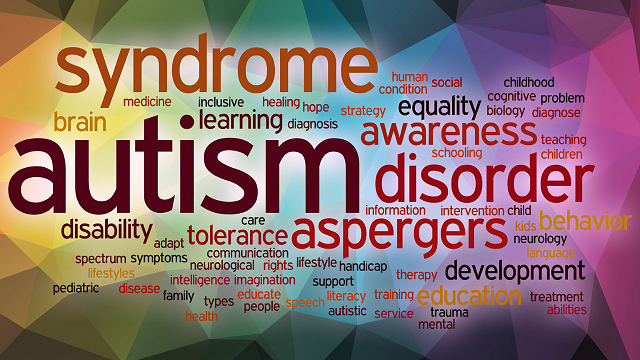According to today’s science, Autism Spectrum Disorder (ASD) is a developmental disability with a broad range of symptoms, including challenges with social skills, repetitive behaviors, speech, and nonverbal communication. However, up until 2013, there were several types of autism, ASD was not an official diagnosis, and “autism” was an umbrella term that grouped five distinct disorders:
- Asperger’s Syndrome
- Autistic Disorder
- Childhood Disintegrative Disorder
- Pervasive Developmental Disorder (PDD-NOS)
- Rett Syndrome
Understanding Outdated Autism Terms
Your doctor should never use the older diagnostic terms for types of autism to describe Autism Spectrum Disorder, but it can still be helpful to familiarize yourself with them. Since ASD has only been a diagnosis for nine years, most people with autism were diagnosed using one of the formerly used terms for different types of autism we explore below:
Asperger’s Syndrome
Asperger’s Syndrome is no longer a recognized diagnostic term in the field. Instead, these individuals might be described as living on the high-functioning end of the spectrum. Some individuals originally diagnosed with Asperger’s have some of the standard features of autism, like challenges related to communications, relationships, and order. But they have certain behaviors that set them apart, such as:
- Unusual speech patterns
- Monotone voice
- Speaking too loudly or in an unusual tone
- Dominating a conversation
People with Asperger’s were characterized as having normal-to-high levels of intelligence. ABA therapy can help individuals with these challenges comprehend how others expect them to communicate. ABA therapy may also help individuals explain their thoughts, wishes, and emotions.
Autistic Disorder
Autistic Disorder was defined by challenges with social interaction, communication, and behavior as outlined below.
At least two of the following qualitative impairments in social interaction:
- Impairment in nonverbal behaviors, including eye contact, facial expressions, gestures, or body postures
- Inability to establish peer relationships
- Lack of interest in others
- Impairment in emotional reciprocity
At least one of the following impairments in communication:
- Deficits or total lack of speech
- If speech is present, the child does not initiate or maintain a conversation with others
- Repetitive use of language
- Limited imaginative play
At least one of the following repetitive, stereotyped, and restricted behaviors, interests, or activities:
- Extreme preoccupation and interest in a restricted or stereotyped pattern of interest
- Inflexibility when it comes to routines and rituals
- Repetitive motor behaviors
- Fascination with specific parts of an object
Childhood Disintegrative Disorder
Individuals formerly diagnosed with Childhood Disintegrative Disorder are unique. These children had what experts called a significant or low-functioning form of autism, but they did not start their lives off that way. Symptoms may not have appeared until age 10. CDD was characterized by children hitting most early developmental milestones but then regressing and losing skills.
Children with this condition would now be classified as having Level 3 Autism Spectrum Disorder. Skills aren’t regained with intervention in these cases, and for some, they will need therapy for the remainder of their lives. Even with intervention, some may not be successful in independent settings.
Pervasive Developmental Disorder–Not Otherwise Specified (PDD-NOS)
Some individuals do not fit into diagnostic criteria with ease. They may have some symptoms but don’t relate to others. These individuals may struggle, but their problems don’t seem severe. In the past, we would have categorized these individuals into a type of autism labeled PDD-NOS. Some experts call this condition “atypical autism.” People with this diagnosis showed:
- Challenges after the age of 3 (children under the age of 3 years old do not meet the criteria for this diagnosis
- Some atypical behaviors (individuals may not have all the symptoms of autism or may exhibit some that aren’t typically associated with autism).
Individuals formerly diagnosed with PDD-NOS have milder forms of autism. They experience fewer social and communication challenges. They also exhibit some strengths. Some individuals with these symptoms need help to live an independent life, find suitable work and build lasting relationships.
Rett Syndrome
Rett Syndrome is a rare genetic disorder that is primarily expressed in girls. It is now a separate diagnosis that was once considered a form of autism. Children with Rett Syndrome might lose previously developed language and self-help skills. One of the main characteristics of Rett Syndrome is the loss of functional hand coordination and abilities. In this case, these children stop using their hands to do things. Instead, they spend vast amounts of time wringing their hands together or clasping at them.
Sadly, Rett Syndrome is also associated with loss of muscle tone and motor development. As a result, many children diagnosed with Rett syndrome need ongoing therapy and lifelong assistance.
History of Autism Diagnosis
The choice to move away from diagnosing several types of autism remains controversial, as some experts in the medical community feel that there should be separate diagnoses for more severe symptoms of autism to ensure that everyone gets the services they need.
Doctors use the Diagnostic and Statistical Manual of Mental Disorders, otherwise known as the DSM-5, when determining how to place patients into diagnostic categories. Before the edition of the DSM-5 was issued in 2013, the conceptions and understanding of autism were different.
Dimensions between the original five conditions often overlapped. For example, someone visiting a doctor might have received a diagnosis of autism. A different doctor might have diagnosed the same person with PDD-NOS diagnosis the next day. This diagnostic confusion led to incomprehensive, inconsistent treatments and strained family units. Families were left questioning which labels were accurate. They also wondered who they could trust with which diagnoses.
In response to this, the DSM-5 replaced these multiple conditions with one term: Autism Spectrum Disorder (ASD). The characteristics of ASD encompass many of the overlaps these conditions can share. We now use the word spectrum to recognize that individuals display a range of conditions, with some having more severe symptoms than others.
In today’s autism field, a doctor will select the term Autism Spectrum Disorder to describe patients. Even though this is the established, correct terminology, you may still hear families use terms like Asperger’s Syndrome or PDD-NOS in casual conversation. Though some may still use these terms, they are outdated and not in line with the DSM-5.
What Is the Correct Terminology for Autism?
Autism Spectrum Disorder is the appropriate terminology for individuals with symptoms characterized as autism; this one-term envelops many behaviors and levels of severity. In contrast, it is still unclear exactly what causes autism. Most experts believe that it is a combination of genetics and the environment. Furthermore, researchers are unclear about what causes some individuals to live with mild impairment while others require 24-hour support. This array of symptoms is why individualized treatment approaches are so imperative for individuals with autism. A one-size-fits-all approach to treating autism can never be effective.
Most Common Signs and Symptoms of Autism Spectrum Disorder
- Lack of response to a stimulus: Often, individuals will not direct their attention to things others point out to them. Additionally, they may not point at an object of interest to others.
- Struggling to establish or maintain relationships: These individuals may have trouble relating to others. They may lack interest in connections or be unsure and awkward when initiating a relationship.
- Sensitivity to touch: Some individuals with autism prefer not to be held, hugged, patted, squeezed, felt, or even touched, even by people they are familiar with and trust.
- Speech impairments: Some autistic people will repeat words, phrases, or echo sounds without forming complete sentences. Others may be completely nonverbal. Some talk extensively, but only about topics that are interesting to them.
- Challenges related to changes in routine: Many people with autism will prefer sameness and become stressed when things change.
- Sensory overload: Some individuals with autism will feel overstimulated by loud noises, smells, or extreme visual stimuli.
- Repetitive and restrictive behaviors: Individuals with autism tend to repeat behaviors that may seem unproductive to others.
Levels of Autism Spectrum Disorder
Autism Spectrum Disorder, as the name implies, encompasses an entire spectrum. Some individuals on the spectrum have a severe impairment, while others are considered higher functioning. The DSM-5 breaks autism into three levels of severity, defined by the amount of support that is necessary. These are:
- Level 1—Requiring Support: At this level, the individual struggles to initiate communication and lacks interest in relationships. They also exhibit inflexible behavior that leads to disruptions in everyday activities.
- Level 2—Requiring Substantial Support: Individuals have apparent difficulty with nonverbal and verbal communication at this level. They demonstrate limited social skills. Their inflexibility makes daily living challenges evident to casual observers.
- Level 3—Requiring Very Substantial Support: At this level, the person has severe communication challenges, both verbally and nonverbally. They have difficulties functioning independently in all areas of life.
Is There a Test for Autism?
There are no blood, laboratory, or physical tests to diagnose individuals with Autism Spectrum Disorder. Instead, specialists use observation skills and employ question-and-answer screening tools to comprehend how their patients function. Getting an accurate diagnosis as soon as possible is crucial. Children diagnosed with ASD before age four often receive more effective treatments through what’s known as early intervention. Children diagnosed later in life do not always respond as effectively and may require medication.
Children as young as two years old can have a routine autism screening check during a wellness visit with their pediatrician. Select school districts offer autism screenings as well. Parents can request a special assessment if their child is missing developmental milestones, expressing delays, or showing any of the autism symptoms previously mentioned.
Controversy Over the Autism Spectrum Disorder Diagnosis
The decision to focus on a single diagnosis to encompass all presentations of autism was intended to improve services and remove barriers. However, some clinicians believe this change from defining different types of autism has been detrimental to autism patients.
A report released by The Autism Society in December 2021 detailed recommendations for improving the quality of life for individuals with autism. One of their recommendations was the addition of a new diagnostic category for those most impaired. This would include individuals with severe intellectual disabilities who are primarily nonverbal and need intensive intervention and supervision.
Some doctors advise that this new category be titled “profound autism.” These experts believe that by creating this category, the needs of the underserved population would be prioritized and more adequately met. This separate category recognizes that select individuals with autism have very different needs. This distinction could help experts develop new treatments and promote education about the differences among autism patients. For this new addition to become a diagnostic category, it would need to be included in the DSM-5.
Treatments for Autism
Every individual diagnosed with Autism Spectrum Disorder (ASD) is unique, and no one treatment helps every person in the same way. The most effective therapies are tailored to meet the needs of the individual, help them overcome challenges, and acquire skills.
Psychological or behavior therapy is often vital for individuals with autism. Doctors will refer patients to professionals and experts who can treat their symptoms. These professionals will administer a treatment team that might include parents, siblings, doctors, and technicians.
Autism therapists will build and administer an effective, individualized treatment plan. It will be essential as parents to reinforce lessons between sessions. Practice and repetition lead to lasting change when it comes to autism treatments. Families play a role in making that possible.
The core challenges of autism will vary among individuals, but many programs will focus on:
- Communication: Asking for a need, examining behavior, and explaining feelings.
- Conversation: Understanding how to listen and respond.
- Generalizing: Learning lessons across settings, people, and environments.
Individuals with severe (Level 3) autism may benefit tremendously from therapies that help them master self-care tasks, like washing hands, brushing teeth, or toileting. Treatment will also be helpful should the child be displaying a challenging behavior like aggression.
Can ABA Therapy Help?
ABA therapy or Applied Behavior Analysis is the gold standard for autism treatment. Technicians and BCBAs work together to identify what clients can and cannot do without support. From there, they target behavior that can be improved. By breaking larger tasks into smaller pieces and practicing drills, the hope is that the task becomes second nature and achievable for the child with time. While ABA therapy can be intensive and seem repetitive, repetition is crucial for progress. When performed appropriately, ABA therapy can change the lives of many people with autism for the better.
Before the development of ABA therapy, autism was primarily considered untreatable. Experts recognize that while there is no cure, many people with autism can benefit from focused and intense intervention. It’s imperative to realize that autism treatment does have limitations. Individuals who are nonverbal may remain nonverbal even after intervention. Some individuals with autism will always feel anxiety in social situations. Therapy doesn’t cure autism, but it can help the person achieve a better quality of life.
ABA Therapy can help make the world more accessible to those with autism. It may also help these individuals better communicate and participate with the world around them. They can learn to express their thoughts and emotions to the people they spend the most time with. These improvements make a huge difference in the lives of everyone touched by the condition.
ABA Centers of America is ready to help anyone affected by autism. If your child or loved one has been diagnosed with autism, learn more about how we can help. Call us at 844-923-4222 for a free, no-obligation consultation. Or message us for more information.







